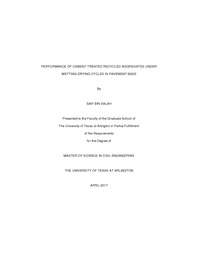| dc.description.abstract | Resilient Modulus (MR) is one of the most important stiffness parameter to determine the thickness of a pavement layer (AASHTO 2003 pavement design guideline). Recent studies conducted by researchers on the variability of MR with wetting-drying (WD) and freeze-thaw (FT) cycles show that long-term durability is an important criterion to be considered in designing pavement base with recycled materials. At present, the design procedure does not consider the effect of deterioration of pavement layers due to seasonal variations and limited studies have been conducted to evaluate the effect of environmental deterioration on the reclaimed asphalt pavement (RAP) and recycled crushed concrete aggregate (RCCA) mixtures stabilized with cement. The objective of this study is to evaluate the long-term durability of RCCA and RAP mix materials under repeated wetting-drying cycles. Three different combinations of RCCA and RAP materials containing 0%, 30% and 50% RAP content were used in this study. Each of these combinations were then stabilized with 4% and 6% cement content. After curing for 7 days the samples prepared from these material combinations were subjected to 4, 8, 16 and 30 wetting-drying (W-D) cycles. For the purpose of comparison, a different set of samples of the same combinations were prepared, cured for 7 days, and then further cured for 15, 25, 40 and 70 days. Resilient modulus tests were then conducted on all the samples at the end of these specified W-D cycles and curing periods. Environmental tests were also conducted to assess the effect of WD cycles on the washed-out water quality. These tests included total suspended solids (TSS), total dissolved solids (TDS), turbidity, chemical oxygen demand (COD) and pH. MR test results indicated that addition of 50% RAP into the mix reduced the resilient modulus (MR) by about 39%. Increasing the cement content from 4% to 6% increased the MR values by about 20-35% for all material combinations. Higher cement content also resulted in higher durability of the materials containing 30% and 50% of RAP. All the six material combinations used in this study showed adequate strength after 7-days of curing. But the mix containing 30% RAP + 70% RCCA 4% cement (30R_4C) and 50% RAP + 50% RCCA 4% cement (50R_4C) failed to meet the minimum layer coefficient value of 0.13 (AASHTO 2003) for pavement base layer after 8-16 wetting-drying cycles. Results obtained from the environmental tests after 30 WD cycles were found to be within the permissible values provided by EPA guidelines. | |

